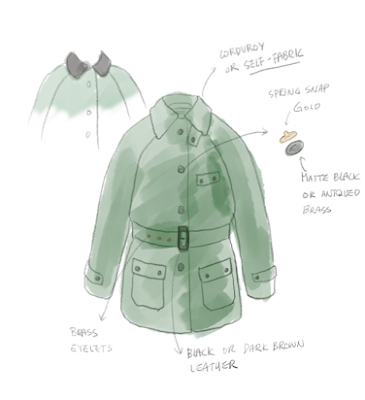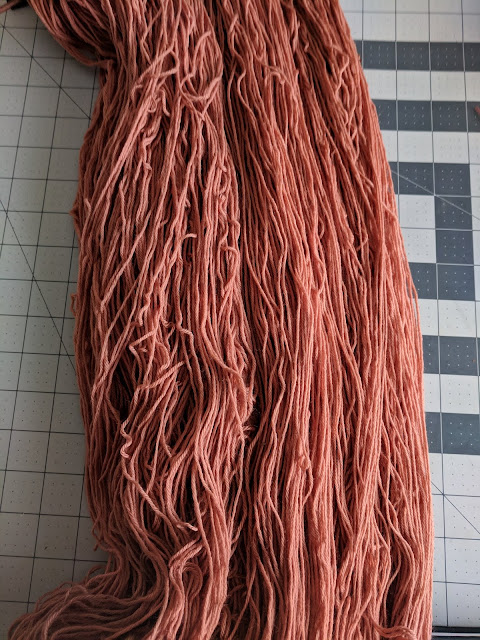I had bought 3 yards of Rag & Bone Olive Stretch Twill from Mood Fabric in March on their 'Green fabric sale' day - impulsively, I regret to say. But I did need a light jacket for transitional weather, so I started collecting inspirations.
 |
| Snapshot of my Pinterest board |
It took me forever to decide on the details but in the end this is what I came up with. I hoped the gold snap buttons inside and the black corduroy collar would make it look more like an adventurer jacket than an army uniform.
For the sewing pattern I chose Pauline & Alice's Serra Jacket, because of the sheer number of options it offers, and I wanted a detachable hood and raglan shoulders and the pattern fitted the bill perfectly. I wanted to combine the views A and C and watching the P&A's online tutorial in hacking the pattern was crucial - otherwise I wouldn't have known I had to extend the neckline for C.
I made a muslin of size small as I was going for a boxy fit, which fitted well except I had to make some narrow shoulder adjustment (not enough as it turned out to be). I also made multiple construction changes including:
- Making sleeves two pieces - this was easy, as I just had to cut from the shoulder point, smooth the lines, and added seam allowances.
- Making back two pieces - again, straightforward. I just added seam allowances to the back piece.
- Using reverse flat felled seams for all seams - next time I'll do proper flat felled seam.
- Interfacing the hems of the jacket
- Making it buggy-lined - for this I referred to my jacket making bible, Tailoring. It entailed drafting front facing to extend to the side seams and creating a half lining piece for the back.
 |
| Modified front-facing |
 |
| From left to right, Even feed walking foot, Stitch in the ditch, and the default foot |
Since I plan to sew more jackets, I invested on some sewing accessories. It was my first time using foots other than the plain default foot or the zipper foot, and I was amazed at how much differences they made. My edge stitching definitely improved thanks to the foot.
I tried lots of techniques for the first time in making this jacket; first buggy lining, first snap buttons, first zipper placket, and least but not last, first pad stitching. I used muslin scraps for interfacing, and used the opportunity to practice pad-stitching. I'm not proud of the stitches, but they hold the muslin and the fabric, and don't show on the outside, so I'm pleased. I also like the fact that I found uses for old muslin pieces. It's more environmentally friendly too. Moving forward I plan to use it more for medium weight interfacing.
 |
| I used muslin scraps for interfacing, pad-stitched with Gutermann cotton thread |
And here's the finished jacket! I'm so so pleased with the result.
 |
| With the hood closed. The buttons actually align, if you look at it from a certain angle. :p |
 |
| The back and the sleeves are modified into two pieces. |
 |
| For the first time, I'm not embarrassed to show the inside of the garment I made. |
 |
| Buggy lined back. There's even a hanging loop! |
 |
| This jacket begs to be styled with binoculars. |
What's my verdict on the pattern? Two thumbs up! The instructions are on the light side so I had to refer to my Barbour jackets and the Tailoring book to figure out lots of things. Definitely not for beginners. But the classic style, easy fitting, and lots of options make this pattern a great investment. I'm already dreaming of making a mix of B and C in brown corduroy.
But next time:
- Remove extra fabric around front shoulder seams to make shoulder narrower (or just make a smaller size)
- Change the pocket to cargo or box pleat pockets, if making a similar style jacket.
- Reduce hood depth.
- Invest on a better zip, maybe. The one from Joann isn't very smooth.
- If making unlined or partially lined, shorten the hem facing so that the stitching line is close to the hem binding (see the picture below).
 |
| Should have shortened the hem. This was highest I could go without overlapping with the pockets. |
This is a milestone in my longer term goal of making a custom tailored tweed jacket, and I think I'm better equipped in terms of my skill sets thanks to sewing this jacket. It isn't 100% finished yet. I still need to make the belt, and I might add a breast pocket after all. But I'm ready to start wearing this right away (weather permitting)!
And now to figure out what to do with the other olive cotton fabric I impulsively bought the same day...








































